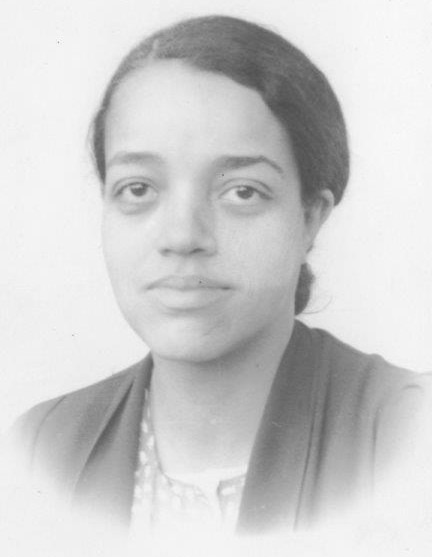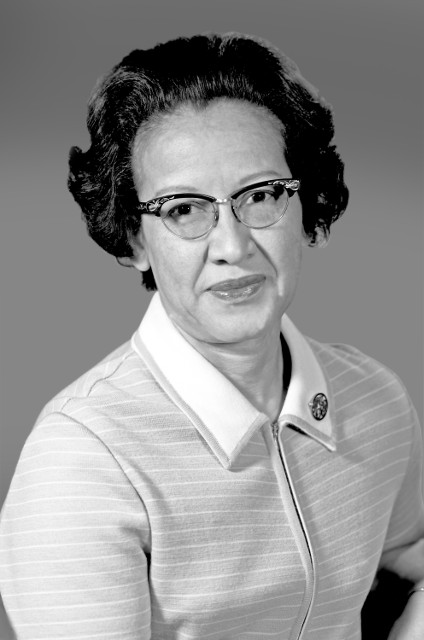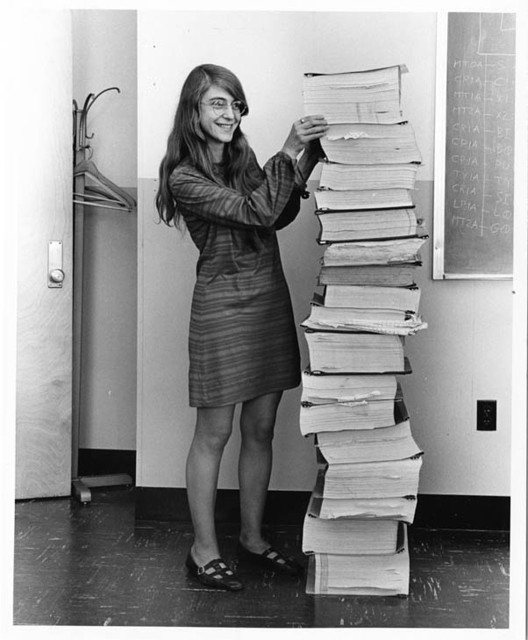There are three main figures I will cover here, whose contributions were vital to NASA's success, and who should act as inspiration for generations to come. These three are Dorothy Vaughan, Katherine Coleman Goble Johnson, and Margaret Hamilton.
First, let's start with the history of NACA. No, that's not a typo; The National Advisory Committee for Aeronautics was the lead research group for air power research in the USA, founded in 1915. In the middle of America's involvement with WWII, May 1943 saw an urgent need at NACA's Langley Memorial Aeronautical Laboratory for hundreds of new workers, many of which would need to be technical staff, and 100 of which were to be "Assistant Computers." At this time, "Computer" still referred to people sitting at desks working through numbers on mechanical calculators; the fully mechanized computer systems would come much later.
As with nearly every other sector of employment in America, there weren't enough men to go around to fill all of these positions, so the personnel officer, Melvin Butler, sought to hire women in the area to fill gaps. Women as mathematicians and computers was nothing new, and many were better at the figures than the male engineers they worked with, but never had so many been hired at once; they would go on to do great things. Though Virginia was segregated, many of Langley's new employees were black, and there was an entire division of "colored computers" that resulted from these hirings.

[Portrait of Dorothy Vaughan, Courtesy of Vaughan Family]
One of that new group of computers was Dorothy Vaughan. Thirty two years old at the time, she had been working as a math teacher at Robert Russa Moton High in Farmville, Virginia. She'd taken up the profession after graduation from Wilberforce University in mathematics and education, turning down a graduate program at Harvard to help her community.
With two children to take care of at home, the much higher salary of a computer at Langley (more than twice what her teaching job paid), and the service she knew it would provide to the country, were too attractive to pass up. Arriving at Langley with the position of Mathematician, Grade P-1, she was guaranteed work until six months after the war ended. Her tenure there would last much, much longer.
The position was not without conflict, however subtle it often was. Segregated white businesses in the area would even cater to German Americans from the internment camps (supposedly kept due to their possible allegiance to the enemy, though none surfaced) and yet would refuse to serve Vaughan because she was black.
And then there was the matter of the cafeteria at Langley. While her computers group had no problem sitting together, the existence of a small cardboard sign reading "colored computers", the only sign at all within the West Area cafeteria, was a silent reminder of their enforced separation from the white members of staff. So, after a time, one of the computers, Miriam Mann, decided to do something about it. "There's my sign for today" she would say, then pry off the sign and fold it up into her purse. A new one would reappear a few days later, and she would take it down. She would repeat this over and over for months until the unseen hands that put the sign up simply stopped bothering to replace it. Just one small battle won in a larger war.
Mrs. Vaughan's fights were more direct, showing what she and her team were capable of. After the war, she stayed on along with much of her team, and would go on to become the head of the West Computing group in 1949, the first black supervisor in NACA. She became famous for knowing which of her computers would be perfect for a given task in the many engineering divisions at Langley, and would often help with choosing new hires, promotions and pay raises. Meanwhile, she often collaborated with other mathematicians, including the white staff, and co-authored some of their publications, such as a handbook for their mechanical calculation methods.
In 1958, NACA combined with other aeronautics agencies into the National Aeronautics and Space Agency, the NASA we are familiar with today. Dorothy Vaughan lost her position as section head when the West Computing group dissolved, but they were combined with other departments into the Analysis and Computation Division (ACD). Segregation in the offices was abolished during the transition, and the new ACD was integrated, both across racial and gender lines. Vaughan would soon work on the Scout Launch Vehicle Program, which would be among the longest-running and most reliable launch systems NASA produced.
Recognizing the future was in electronic computers, Vaughan became an expert FORTRAN programmer, and encouraged many of her colleagues to do the same. Thus, the computers transitioned from running through figured by hand, to now programming the very methods their mechanical replacements would perform in their stead. Work went hundreds to thousands of times faster, but few of their staff would be replaced, because someone always needs to do the programming.

[Portrait of Katherine Johnson, NASA]
Katherine Coleman Goble Johnson, born Katherine Coleman, had her own breakthroughs to make. Born in West Virginia in 1918, she would demonstrate remarkable curiosity and strength in mathematics, entering high school at age thirteen, and afterward entering WV State College at eighteen. She burned through the mathematics curriculum, and graduated with honors in 1937, taking up a teaching job in neighboring Virginia state.
West Virginia chose to integrate its graduate schools in 1939. West Virginia State University's president picked three black students to integrate the program, and Katherine was among them. She took the offer, but turned down the complete program to start a family with her husband, James Goble. When her three daughters got old enough, she went back into teaching for a time, until the offer for new computers at the West Area group came in 1952. She and her husband chose to move to Langley, to the Newport News community where Dorothy Vaughan also lived.
When she entered, Vaughan soon took a liking to her. They'd known each other's families back in West Virginia, and Vaughan knew within two weeks just where she would work best. She sent Katherine Goble to the Flight Research Division on a "temporary" assignment that soon became permanent, like so many others. She would spend the next four years analyzing flight test data, and at one point would discover the effects of turbulence caused by the wakes of nearby planes, a discovery that would change air travel regulations throughout the world. Sadly, her husband would die of a brain tumor in 1956, as she was finishing up this work.
As the 1957 Soviet launch of the Sputnik satellite spurred the American end of the space race, Katherine's work would move towards space flight research. In 1958 she made contributions to the Notes on Space Technology document, lectures given by Flight Research Division and Pilotless Aircraft Research Division engineers. Engineers from both groups would be combined into the Space Task Group NACA's (and very soon NASA's) first official space travel group, with Katherine coming along with the program.
Katherine would go on to analyze trajectories for Freedom 7, Alan Shepard's May 1961 spaceflight marking the first American human in space; to coauthor a paper with Ted Skopinski on how to land an orbital flight vehicle on a specific part of the globe, the first ever woman co-authored on a FRD paper; and would be hand-picked by John Glenn as the only person he trusted to check the calculations on his trajectory in the Friendship 7 Mercury mission. That mission had to be precise, from launch, through orbit, to descent and a precise splash-down in a span of ocean only 20 miles wide. She double-checked all the numbers the electronic computers were producing, by hand, on a mechanical calculator. The resulting spaceflight was a resounding success, and a turning point in the space race.
Katherine Johnson would continue work at NASA until 1986, working on the various vehicles and systems that made space travel possible. She counts as her greatest achievement her work on Project Apollo's Lunar Lander, synching its movements to rendezvous with the Command and Service Module that remained in orbit around the moon until they needed to take it with them to Earth.
Johnson was awarded the Presidential Medal of Freedom in 2015, at age 97, by then President Barack Obama.

[Margaret Hamilton standing with a stack of Apollo Guidance Computer source code, courtesy MIT Museum]
Margaret Hamilton was another mathematician and programmer, working at the MIT Instrumentation Lab starting from 1960, age 24. With John F. Kennedy's Apollo program launched in 1961, software to run the various systems aboard the space vehicles involved would be vital. The trouble was, the very notion of software in the modern sense did not exist. You simply wrote a program, put it into the machine, and ran it; if the program was to be hundreds of thousands of miles from Earth, it was infeasible to load individual punch cards into the machine, so how would you even load the program?
Hamilton led the team that developed the building blocks of the procedure for constructing and loading these programs, a system she coined "software engineering." The term has stuck, and is in wide usage today. The procedure involved careful error checking, and rigorous testing of the software before release, to ensure the programs would function as expected. This was of vital importance when astronauts depended on those computers to guide them through the vacuum of space; if most software engineers today had such weighty concerns in mind when producing their code, perhaps they would be as thorough as Hamilton's team!
The Apollo computers were two 70 pound "portable" machines that communicated with each other to perform fly by wire. One was aboard the lunar lander module, the other aboard the command module that would wait in lunar orbit. The computers' software was stored in its ROM, with a small RAM cache available for working memory; the storage limits of both could be measured in mere kilobytes in modern terms.
Working on Apollo 8 in 1968, Hamilton's young daughter Lauren had been poking about in the simulator, and had accidentally caused a system crash by activating a pre-flight program, P01, during flight. Hamilton then tried to include an error checking routine that would P01 from causing this crash. NASA higher-ups insisted the astronauts were trained to be "perfect" and would never make such a mistake. Hamilton wasn't so sure, but without permission to include the error checks, she included a note of "Do not select P01 during flight" in the program's documentation.
Sure enough, five days into Apollo 8's space flight, right around Christmas, Jim Lovell in the capsule accidentally pressed the P01 switch. The program reset all of the navigation data Lovell had been collecting on the mission. Without this data, the computer wouldn't know how to get the astronauts home. So, Hamilton and the rest of the MIT team had to pore through the documentation, and the program listing (8 inches thick of paper).
They figured out how to upload new navigational data into the computer to replace what they had lost, and in so doing, they knew everything would be OK. But if they had realized human error isn't something you can fix completely with training, they would have listened to Hamilton, and let her team add the error checking code.
The MIT software engineering regimen proved itself when, on 20 July 1969, the Apollo 11 lunar lander was about to touch down on the Sea of Tranquility on the Moon. Here, the machine put up a "1202 alarm," a warning that, it turned out, was an indicator the computer was prioritizing the landing system over less immediate tasks, like the rendezvous radar. Once the meaning of the warning was understood, the crew completed the first ever human landing on the moon's surface.
On November 22, 2016, Margaret Hamilton received the Presidential Medal of Freedom from then-President Barack Obama, commemorating her contributions and leadership in the space program's software engineering group.
If you would like to know more about Katherine Johnson and Dorothy Vaughan, and a few other black women in the Langley facility responsible for aiding the space program, I highly recommend the book Hidden Figures, by Margot Lee Shetterly.
Sources:
Margot Lee Shetterly, Hidden Figures, William Morrow 2016.
Margot Lee Shetterly, Dorothy Vaughan Biography, NASA 2016, Retrieved from https://www.nasa.gov/content/dorothy-vaughan-biography on May 21, 2017.
Margot Lee Shetterly, Katherine Johnson Biography, NASA 2016, Retrieved from https://www.nasa.gov/content/katherine-johnson-biography on May 21, 2017.
Nicholas P. Russo, "Margaret Hamilton, Apollo Software Engineer, Awarded Presidential Medal of Freedom", NASA, 22 Nov 2016, Retrieved from https://www.nasa.gov/feature/margaret-hamilton-apollo-software-engineer-awarded-presidential-medal-of-freedom on May 21, 2017.
Robert McMillan, "Her Code Got Humans on the Moon—And Invented Software Itself", Wired Magazine, 13 November 2015, Retrieved from https://www.wired.com/2015/10/margaret-hamilton-nasa-apollo/ on May 21, 2017.
Exercise: Quiz Yourself (Computers at NASA)
After reading the above history (or reviewing again now), ask yourself the following questions about what you read, and make sure you know how to answer correctly.
The name of the organization that would one day become the National Aeronautics and Space Administration was NACA. What did this stand for?
When was segregation abolished in the NACA/NASA offices?
What was Dorothy Vaughan's job from 1949 to 1958?
What major project was Vaughan involved in while at the Analysis and Computation Division?
As electronic computers became more common and the jobs of human computers were no longer assured, what did Dorothy Vaughan do to ensure her future and that of her computer group?
How did Dorothy Vaughan know Katherine Johnson before Langley?
What profession did both Katherine Johnson and Dorothy Vaughan have before applying for Langley?
What event spurred the United States of America's entry into the space race?
What was the topic of the paper Katherine Johnson co-authored with Ted Skopinski?
Who asked specifically for Katherine Johnson to recheck the calculations on the Friendship 7 Mercury mission?
What does Katherine Johnson count as her greatest achievement?
What was Margaret Hamilton's primary contribution to computer science?
What did Margaret Hamilton's team at MIT produce for NASA?
What caused the computer malfunction aboard Apollo 8?
Is it right to program as if human error will never be a factor?
What was the "1202 alarm" and what did it do for Apollo 11?